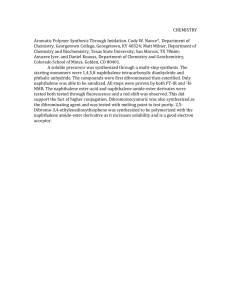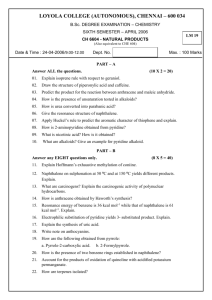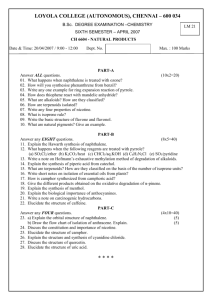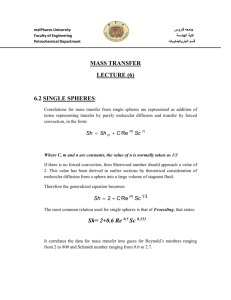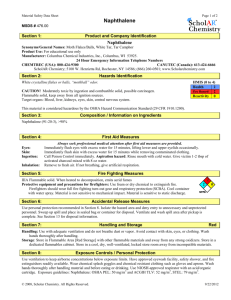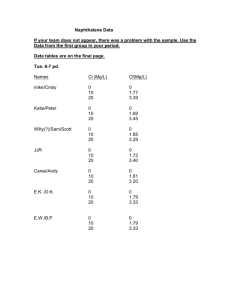Organig chemistry
advertisement
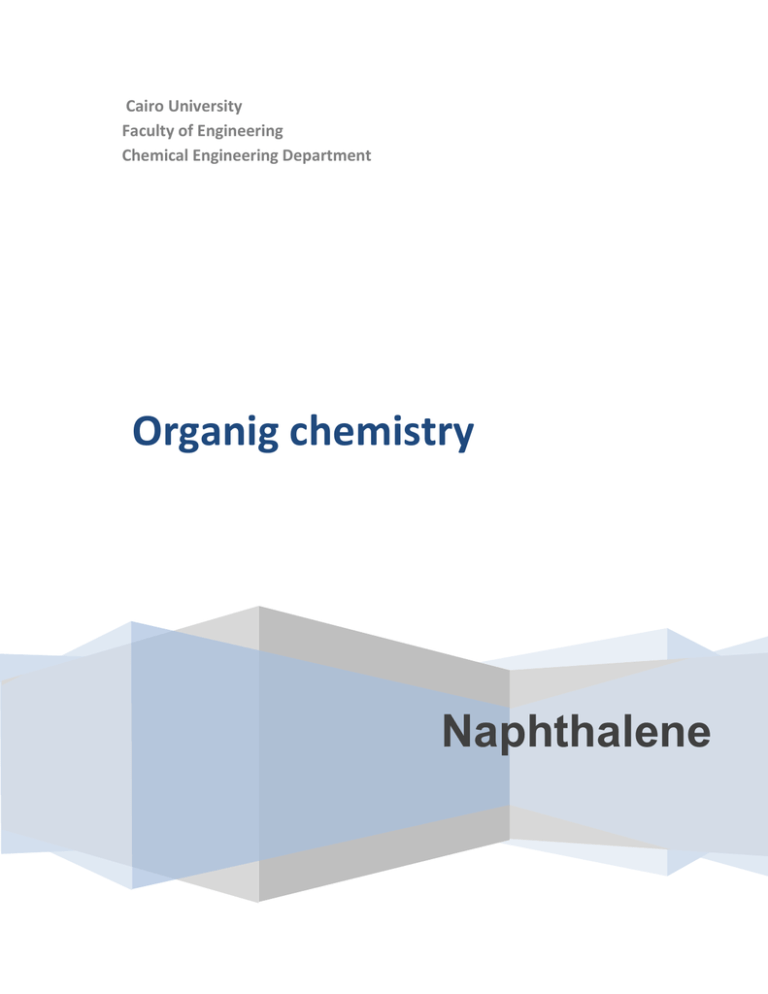
Cairo University Faculty of Engineering Chemical Engineering Department Organig chemistry Naphthalene Cairo University Faculty of Engineering Chemical Engineering Department Organig chemistry Naphthalene 1-Afaf Hassanien 2-Ragaa Ramadan 3-Mervat Samy 4-Patricia Ernest sec :2 sec :2 sec :4 sec :2 B.N :31 B.N :16 B.N:1 B.N: 6 What is Naphthalene? Naphthalene (also known as naphthalin, naphthaline, moth ball, tar camphor, white tar, or albocarbon).Naphthalene is an organic compound with formula C10H8. It is a white crystalline solid with a characteristic odor. As an aromatic hydrocarbon, naphthalene's structure consists of a fused pair of benzene rings. It is best known as the traditional ingredient(s) of mothballs. History In 1819–1820, at least two chemists reported a white solid with a pungent odor derived from the distillation of coal tar. In 1821, John Kidd described many of this substance's properties and the means of its production, and proposed the name naphthalene, as it had been derived from a kind of naphtha. In 1826, Naphthalene's chemical formula was determined by Michael Faraday. In 1866, the structure of two fused benzene rings was proposed by Emil Erlenmeyer, and confirmed by Carl Gräbe three years later. Properties Molecular formula : C10H8 Molar mass : 128.17052g/mol Appearance : White solid crystals/flakes, Density : 1.14 g/cm³ Melting point : 81.2 °C Boiling point : 218 °C Solubility : Insoluble in wate production Most naphthalene is derived from coal tar. From the 1960s until the 1990s, significant amounts of naphthalene were also produced from heavy petroleum fractions during petroleum refining, but today petroleum-derived naphthalene represents only a minor component of naphthalene production. Naphthalene is the most abundant single component of coal tar. Although the composition of coal tar varies with the coal from which it is produced, typical coal tar is about 10% naphthalene by weight. In industrial practice, distillation of coal tar yields an oil containing about 50% naphthalene, along with a variety of other aromatic compounds. This oil, after being washed with aqueous sodium hydroxide to remove acidic components (chiefly various phenols), and with sulfuric acid to remove basic components, undergoes fractional distillation to isolate naphthalene. The crude naphthalene resulting from this process is about 95% naphthalene by weight, often referred to as 78°C (melting point). Uses 1- Naphthalene is used in explosives. 2- As a fumigant The most familiar use of naphthalene is as a household fumigant, such as in mothballs although 1,4-dichlorobenzene (or p-dichlorobenzene) is now more widely used. In a sealed container containing naphthalene pellets, naphthalene vapors build up to levels toxic to both the adult and larval forms of many moths that attack textiles. Other fumigant uses of naphthalene include use in soil as a fumigant pesticide, in attic spaces to repel animals and insects, and in museum storage-drawers and cupboards to protect the contents from attack by insect pests. 3- Naphthalene is used in engineering to study heat transfer using mass sublimation. 4- It`s used in tanning leather applications, insecticide, antiseptic, lubricant, dye, resin, solvents, and plastics. Health effects Exposure to large amounts of naphthalene may damage or destroy red blood cells. Humans, particularly children, have developed this condition, known as hemolytic anemia, after ingesting mothballs or deodorant blocks containing naphthalene. Symptoms include fatigue, lack of appetite, restlessness, and pale skin. Exposure to large amounts of naphthalene may cause confusion, nausea, vomiting, diarrhea; blood in the urine .The International Agency for Research on Cancer classifies naphthalene as possibly carcinogenic to humans and animals. References 1- McMurry, John. 2004. Organic Chemistry, 6th ed. Belmont, CA: Brooks/Cole. 2- Morrison, Robert T. and Robert N. Boyd. 1992. Organic Chemistry, 6th ed. Englewood Cliffs, NJ: Prentice Hall. 3- Solomons, T.W. Graham and Craig B. Fryhle. 2004. Organic Chemistry, 8th ed. Hoboken, NJ: John Wiley
